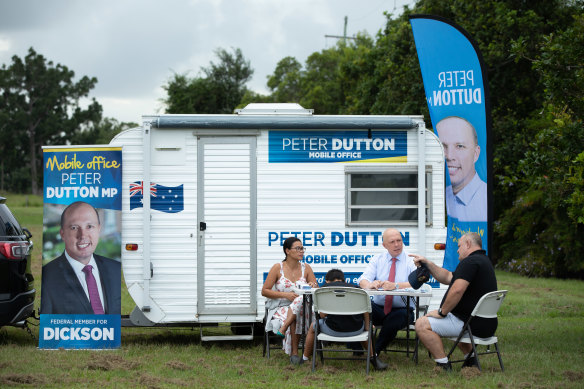Next Sunday marks the first anniversary of the election of the Albanese government. As the government continues to ride high in the polls, the Liberal Party remains firmly in the political doldrums. Yet interest rates are punishingly high, the nation faces a cost-of-living crisis, and economic growth is collapsing. Why has the opposition been unable to make more headway?
One reason often suggested is demography: younger voters are increasingly alienated from conservative parties. Yet, it was ever thus: the Liberal Party’s past electoral success was never based on capturing the under 30s. The loss of younger voters is actually a problem common to both major parties. If you are under 25, you are as likely to vote Green as you are to vote Labor; that trend is set to continue.

Peter Dutton meets locals in his north Brisbane seat of Dickson.Credit: Paul Harris
At least as important to the Liberals’ current woes as demography, is geography. The Liberal Party is today less representative of metropolitan Australia than it has ever been. Add to that the proportionately larger influence within the Coalition of the National Party – whose electoral base has held firm while the Liberals bled marginal seats in the cities – and the opposition today is overwhelmingly a party of regional voices.
This is evident in the makeup of the Coalition leadership. Not one of the six who occupy leadership positions comes from Sydney or Melbourne. The largest city represented in the leadership group is Brisbane (Peter Dutton’s electorate Dickson is on Brisbane’s northern outskirts). The two Senate leaders (Simon Birmingham and Michaelia Cash) come from the smaller capital cities (Adelaide and Perth respectively).
Of the other three (Liberal Deputy Sussan Ley, and the Nationals’ leaders David Littleproud and Perin Davey) two hail from southern NSW and one from western Queensland. Most of the other senior frontbenchers also live in regional Australia, including Angus Taylor (Goulburn), Dan Tehan (western Victoria), Barnaby Joyce (New England) and Ted O’Brien (Sunshine Coast). Of the 24 members of Dutton’s shadow cabinet, only seven – slightly more than a quarter – are from Australia’s three largest cities.
Loading
The weighting away from the large cities is even more pronounced in the opposition party room. Of the 56 Coalition members of the House of Representatives, only 16 represent electorates in Australia’s eight capitals (Sydney, 7; Melbourne, 2; Brisbane, 4; Perth, 2; Adelaide, 1; Hobart, 0; Canberra, 0; Darwin, 0). The aggregate population of the capital cities is about 17.5 million – more than two-thirds of Australia’s 26 million people. Yet the capital city electorates represented by Liberal MPs are barely more than 10 per cent of the House of Representatives. Even taking into account senators, most of whom are capital-city based, the figures do not get a lot better.
By far the largest proportion of Coalition MPs comes from Queensland: 21 of the 56. As I well know, having represented the state in the Senate for 18 years, Queensland is predominantly regional in character. It is the only mainland state where most of the population lives outside the capital city. While the politics of NSW are dominated by Sydney and the politics of Victoria are largely about Melbourne, the politics of Queensland are not, primarily, the politics of Brisbane, which is often radically at variance from the rest of the state.
Modern Brisbane is a progressive city within a conservative state. While regional Queensland is the bastion of One Nation, Brisbane elects more Green MPs than Melbourne. Only four of the 21 Queensland Coalition MPs come from Brisbane. The other 17 – more than 30 per cent of all Coalition MPs – are from regional Queensland, as are most of the senators.
